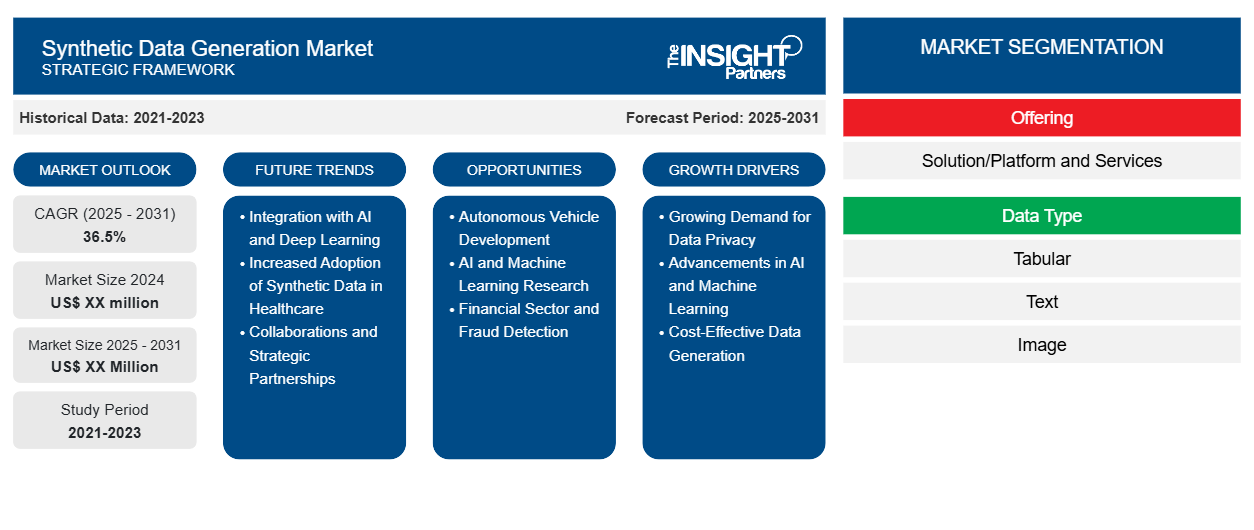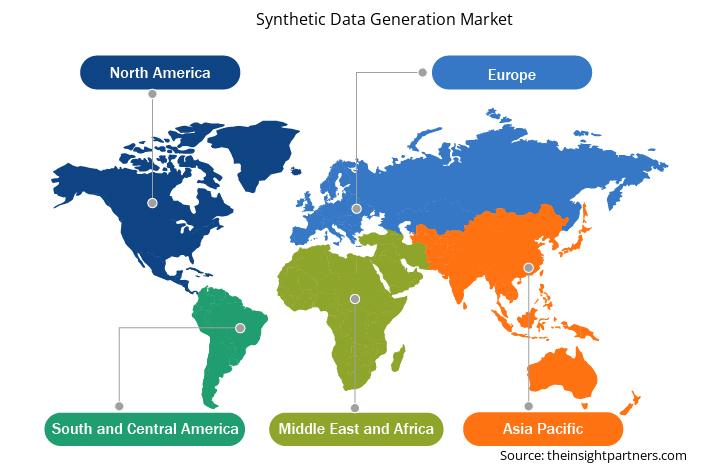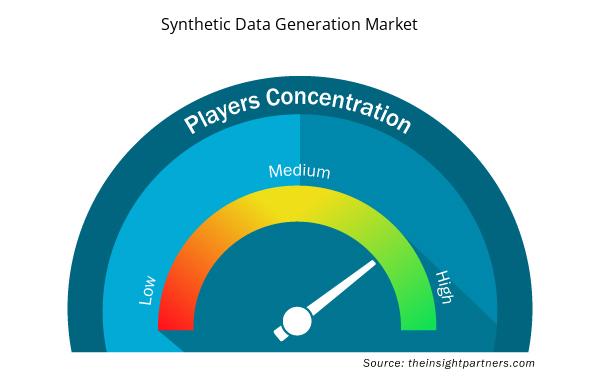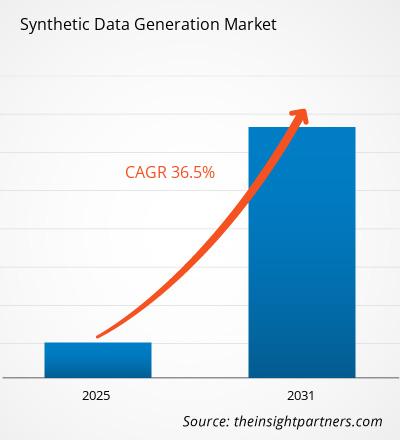من المتوقع أن يسجل سوق توليد البيانات الاصطناعية معدل نمو سنوي مركب بنسبة 36.5٪ من عام 2025 إلى عام 2031، مع توسع حجم السوق من XX مليون دولار أمريكي في عام 2024 إلى XX مليون دولار أمريكي بحلول عام 2031.
يُقسّم التقرير حسب العرض (الحلول/المنصة والخدمات)، ونوع البيانات (جداول، ونصوص، وصور، وفيديو)، والتطبيق (تدريب وتطوير الذكاء الاصطناعي/التعلم الآلي، وإدارة بيانات الاختبار). ويُفصّل التحليل العالمي بشكل أكبر على المستوى الإقليمي والدول الرئيسية. ويُقدّم التقرير القيمة بالدولار الأمريكي للتحليل والقطاعات المذكورة أعلاه.
غرض التقرير
يهدف تقرير "سوق توليد البيانات الاصطناعية" الصادر عن شركة "ذا إنسايت بارتنرز" إلى وصف المشهد الحالي والنمو المستقبلي، وأهم العوامل المحفزة، والتحديات، والفرص المتاحة. وسيوفر هذا التقرير رؤى ثاقبة لمختلف أصحاب المصلحة في قطاع الأعمال، مثل:
- مزودي التكنولوجيا/المصنعين: لفهم ديناميكيات السوق المتطورة ومعرفة فرص النمو المحتملة، وتمكينهم من اتخاذ قرارات استراتيجية مستنيرة.
- المستثمرون: إجراء تحليل شامل للاتجاهات فيما يتعلق بمعدل نمو السوق، والتوقعات المالية للسوق، والفرص المتاحة عبر سلسلة القيمة.
- الهيئات التنظيمية: لتنظيم السياسات ومراقبة الأنشطة في السوق بهدف تقليل الانتهاكات والحفاظ على ثقة المستثمرين ودعم سلامة السوق واستقرارها.
تجزئة سوق توليد البيانات الاصطناعية
عرض
- الحلول/المنصة والخدمات
نوع البيانات
- مجدول
- نص
- صورة
- فيديو
طلب
- تدريب وتطوير الذكاء الاصطناعي والتعلم الآلي
- إدارة بيانات الاختبار
الجغرافيا
- أمريكا الشمالية
- أوروبا
- آسيا والمحيط الهادئ
- الشرق الأوسط وأفريقيا
- أمريكا الجنوبية والوسطى
قم بتخصيص هذا التقرير ليناسب متطلباتك
ستحصل على تخصيص لأي تقرير - مجانًا - بما في ذلك أجزاء من هذا التقرير، أو تحليل على مستوى الدولة، وحزمة بيانات Excel، بالإضافة إلى الاستفادة من العروض والخصومات الرائعة للشركات الناشئة والجامعات
سوق توليد البيانات الاصطناعية: رؤى استراتيجية

- احصل على أهم اتجاهات السوق الرئيسية لهذا التقرير.ستتضمن هذه العينة المجانية تحليل البيانات، بدءًا من اتجاهات السوق وحتى التقديرات والتوقعات.
عوامل نمو سوق توليد البيانات الاصطناعية
- تزايد الطلب على خصوصية البيانات: تُمكّن البيانات المُصنّعة المؤسسات من إنشاء مجموعات بيانات دون المساس بخصوصية المستخدم. فهي تُوفّر حلاً فعّالاً للتخفيف من مخاوف الخصوصية، لا سيما في قطاعات مثل الرعاية الصحية والمالية، حيث تُعدّ المعلومات الشخصية الحساسة ذات أهمية. من خلال توليد بيانات مُصنّعة تُحاكي البيانات الواقعية، يُمكن للشركات تدريب نماذج الذكاء الاصطناعي دون الكشف عن الهويات الحقيقية، مما يُساعد على الامتثال للوائح حماية البيانات، مثل اللائحة العامة لحماية البيانات (GDPR).
- التطورات في الذكاء الاصطناعي والتعلم الآلي: أدى التقدم في تقنيات الذكاء الاصطناعي والتعلم الآلي إلى زيادة الطلب على البيانات التركيبية. ومع الحاجة إلى مجموعات بيانات ضخمة ومتنوعة لتدريب النماذج المعقدة، يُسهم توليد البيانات التركيبية في معالجة ندرة البيانات، خاصةً للتطبيقات المتخصصة أو شديدة التخصص. كما يُسرّع هذا التوليد تطوير النماذج من خلال توفير بيانات عالية الجودة ومتنوعة دون الحاجة إلى بيانات واقعية باهظة الثمن أو يصعب الوصول إليها.
- توليد بيانات فعّال من حيث التكلفة: قد يكون جمع بيانات العالم الحقيقي وتصنيفها مكلفًا ويستغرق وقتًا طويلًا، خاصةً لمهام مثل القيادة الذاتية أو الأبحاث الطبية. يُخفّض توليد البيانات الاصطناعية هذه التكاليف بشكل كبير. فهو يُمكّن الشركات من إنشاء كميات هائلة من البيانات بسرعة وبتكلفة معقولة، مما يُمكّن من تدريب واختبار النماذج بشكل أسرع. وهذا مفيد بشكل خاص في المجالات التي تتطلب تحديثات مستمرة أو عمليات محاكاة واسعة النطاق.
اتجاهات مستقبل سوق توليد البيانات الاصطناعية
- التكامل مع الذكاء الاصطناعي والتعلم العميق: يتزايد التوجه نحو دمج البيانات التركيبية مع نماذج الذكاء الاصطناعي والتعلم العميق المتقدمة. أصبحت أدوات توليد البيانات التركيبية المعتمدة على الذكاء الاصطناعي أكثر تطورًا، وقادرة على إنشاء مجموعات بيانات واقعية وعالية الجودة، مصممة خصيصًا لتلبية احتياجات تدريبية محددة. ونظرًا لأن تقنيات التعلم العميق تتطلب كميات هائلة من البيانات المصنفة، فإن استخدام البيانات التركيبية لتدريب النماذج بكفاءة أكبر يكتسب زخمًا متزايدًا في مختلف القطاعات.
- تزايد اعتماد البيانات الاصطناعية في الرعاية الصحية: مع تزايد المخاوف بشأن خصوصية البيانات وتشديد المتطلبات التنظيمية، يتزايد اعتماد قطاع الرعاية الصحية على البيانات الاصطناعية لتدريب نماذج التعلم الآلي. وتستفيد مؤسسات الرعاية الصحية من مجموعات البيانات الاصطناعية لتطوير حلول للتصوير الطبي، واكتشاف الأدوية، ونماذج رعاية المرضى، مع ضمان سرية هوية المرضى. ويعزز هذا التوجه الحاجة إلى مجموعات بيانات ضخمة تُحسّن دقة الذكاء الاصطناعي دون المساس بالخصوصية.
- التعاون والشراكات الاستراتيجية: تُشكّل العديد من الشركات في سوق البيانات الاصطناعية تحالفات استراتيجية لتعزيز عروضها. ومن خلال التعاون مع شركات الذكاء الاصطناعي، ومؤسسات البحث، ومقدمي الرعاية الصحية، تهدف هذه الشركات إلى الاستفادة من خبرات وموارد بعضها البعض لتطوير تقنيات توليد البيانات الاصطناعية. وتُسهم هذه الشراكات في تطوير حلول أكثر ملاءمة لمختلف القطاعات، مما يُسرّع من اعتماد البيانات الاصطناعية.
فرص سوق توليد البيانات الاصطناعية
- تطوير المركبات ذاتية القيادة: يستفيد قطاع المركبات ذاتية القيادة من البيانات التركيبية لمحاكاة سيناريوهات قيادة متنوعة قد يصعب أو يشكّل خطرًا على إعادة إنتاجها في العالم الواقعي. تُمكّن البيانات التركيبية من إنشاء نماذج متنوعة لظروف الطرق والطقس وسلوكيات المرور، وهي أمور حيوية لتدريب واختبار أنظمة الذكاء الاصطناعي في السيارات ذاتية القيادة. تُساعد هذه الفرصة على تسريع عملية التطوير مع ضمان السلامة والموثوقية.
- أبحاث الذكاء الاصطناعي والتعلم الآلي: يمكن للباحثين في مجال الذكاء الاصطناعي والتعلم الآلي الاستفادة من البيانات التركيبية لتدريب الخوارزميات في الحالات التي قد تكون فيها البيانات الواقعية نادرة أو غير تمثيلية بما يكفي. في تطبيقات مثل معالجة اللغة الطبيعية (NLP) أو الرؤية الحاسوبية، توفر البيانات التركيبية المرونة اللازمة لإنشاء مجموعات بيانات محددة لأغراض التدريب، مما يقلل الاعتماد على البيانات الخاصة، ويفتح آفاقًا جديدة للأبحاث الأكاديمية والصناعية.
- القطاع المالي وكشف الاحتيال: في القطاع المالي، يُمكن استخدام البيانات المُركّبة لمحاكاة المعاملات والأحداث المالية والأنشطة الاحتيالية دون الكشف عن معلومات العملاء الحساسة. من خلال تدريب نماذج الذكاء الاصطناعي على مجموعات البيانات المُركّبة، يُمكن للمؤسسات المالية تحسين قدراتها على كشف الاحتيال والحد من المخاطر مع ضمان خصوصية البيانات. كما تُتيح هذه الفرصة إنشاء مجموعات بيانات أكثر تنوعًا لتحسين التنبؤات المالية وتحليل اتجاهات السوق.
رؤى إقليمية حول سوق توليد البيانات الاصطناعية
قام محللو إنسايت بارتنرز بشرح شامل للاتجاهات والعوامل الإقليمية المؤثرة في سوق توليد البيانات الاصطناعية خلال فترة التوقعات. ويناقش هذا القسم أيضًا قطاعات سوق توليد البيانات الاصطناعية ونطاقه الجغرافي في أمريكا الشمالية، وأوروبا، وآسيا والمحيط الهادئ، والشرق الأوسط وأفريقيا، وأمريكا الجنوبية والوسطى.

- احصل على البيانات الإقليمية المحددة لسوق توليد البيانات الاصطناعية
نطاق تقرير سوق توليد البيانات الاصطناعية
| سمة التقرير | تفاصيل |
|---|---|
| حجم السوق في عام 2024 | XX مليون دولار أمريكي |
| حجم السوق بحلول عام 2031 | XX مليون دولار أمريكي |
| معدل النمو السنوي المركب العالمي (2025 - 2031) | 36.5% |
| البيانات التاريخية | 2021-2023 |
| فترة التنبؤ | 2025-2031 |
| القطاعات المغطاة | عن طريق العرض
|
| المناطق والدول المغطاة | أمريكا الشمالية
|
| قادة السوق وملفات تعريف الشركات الرئيسية |
|
كثافة اللاعبين في سوق توليد البيانات الاصطناعية: فهم تأثيرها على ديناميكيات الأعمال
يشهد سوق توليد البيانات الاصطناعية نموًا سريعًا، مدفوعًا بتزايد طلب المستخدم النهائي نتيجةً لعوامل مثل تطور تفضيلات المستهلكين، والتقدم التكنولوجي، وزيادة الوعي بمزايا المنتج. ومع تزايد الطلب، تعمل الشركات على توسيع عروضها، والابتكار لتلبية احتياجات المستهلكين، والاستفادة من الاتجاهات الناشئة، مما يعزز نمو السوق.
تشير كثافة اللاعبين في السوق إلى توزيع الشركات العاملة في سوق أو قطاع معين. وتشير إلى عدد المنافسين (اللاعبين في السوق) الموجودين في سوق معين نسبةً إلى حجمه أو قيمته السوقية الإجمالية.
الشركات الرئيسية العاملة في سوق توليد البيانات الاصطناعية هي:
- مايكروسوفت
- جوجل
- آي بي إم
- أمازون ويب سيرفيسز
- إنفيديا
- أوبن أيه آي
إخلاء المسؤولية : الشركات المذكورة أعلاه ليست مرتبة بأي ترتيب معين.

- احصل على نظرة عامة على أهم اللاعبين الرئيسيين في سوق توليد البيانات الاصطناعية
نقاط البيع الرئيسية
- التغطية الشاملة: يغطي التقرير بشكل شامل تحليل المنتجات والخدمات والأنواع والمستخدمين النهائيين لسوق توليد البيانات الاصطناعية، مما يوفر مشهدًا شاملاً.
- تحليل الخبراء: تم تجميع التقرير على أساس الفهم العميق لخبراء الصناعة والمحللين.
- معلومات محدثة: يضمن التقرير أهمية الأعمال التجارية بسبب تغطيته للمعلومات الحديثة واتجاهات البيانات.
- خيارات التخصيص: يمكن تخصيص هذا التقرير لتلبية متطلبات العملاء المحددة وتلبية استراتيجيات العمل بشكل مناسب.
لذا، يُمكن أن يُساعد تقرير البحث حول سوق توليد البيانات الاصطناعية في تمهيد الطريق لفهم سيناريوهات الصناعة وآفاق نموها. ورغم وجود بعض المخاوف المُبررة، إلا أن فوائد هذا التقرير الإجمالية تفوق عيوبه.
- التحليل التاريخي (سنتان)، السنة الأساسية، التوقعات (7 سنوات) مع معدل النمو السنوي المركب
- تحليل PEST و SWOT
- حجم السوق والقيمة / الحجم - عالميًا وإقليميًا وقطريًا
- الصناعة والمنافسة
- مجموعة بيانات Excel



Report Coverage
Revenue forecast, Company Analysis, Industry landscape, Growth factors, and Trends

Segment Covered
This text is related
to segments covered.

Regional Scope
North America, Europe, Asia Pacific, Middle East & Africa, South & Central America

Country Scope
This text is related
to country scope.
الأسئلة الشائعة
Some of the customization options available based on the request are an additional 3–5 company profiles and country-specific analysis of 3–5 countries of your choice. Customizations are to be requested/discussed before making final order confirmation# as our team would review the same and check the feasibility
The report can be delivered in PDF/PPT format; we can also share excel dataset based on the request
Increased Adoption of Synthetic Data in Healthcare, Collaborations and Strategic Partnerships, Synthetic Data for Edge and IoT Applications
Growing Demand for Data Privacy, Advancements in AI and Machine Learning, Cost-Effective Data Generation
The global Synthetic Data Generation market is expected to grow at a CAGR of 36.5% during the forecast period 2024 - 2031
Trends and growth analysis reports related to Technology, Media and Telecommunications : READ MORE..
The Insight Partners performs research in 4 major stages: Data Collection & Secondary Research, Primary Research, Data Analysis and Data Triangulation & Final Review.
- Data Collection and Secondary Research:
As a market research and consulting firm operating from a decade, we have published and advised several client across the globe. First step for any study will start with an assessment of currently available data and insights from existing reports. Further, historical and current market information is collected from Investor Presentations, Annual Reports, SEC Filings, etc., and other information related to company’s performance and market positioning are gathered from Paid Databases (Factiva, Hoovers, and Reuters) and various other publications available in public domain.
Several associations trade associates, technical forums, institutes, societies and organization are accessed to gain technical as well as market related insights through their publications such as research papers, blogs and press releases related to the studies are referred to get cues about the market. Further, white papers, journals, magazines, and other news articles published in last 3 years are scrutinized and analyzed to understand the current market trends.
- Primary Research:
The primarily interview analysis comprise of data obtained from industry participants interview and answers to survey questions gathered by in-house primary team.
For primary research, interviews are conducted with industry experts/CEOs/Marketing Managers/VPs/Subject Matter Experts from both demand and supply side to get a 360-degree view of the market. The primary team conducts several interviews based on the complexity of the markets to understand the various market trends and dynamics which makes research more credible and precise.
A typical research interview fulfils the following functions:
- Provides first-hand information on the market size, market trends, growth trends, competitive landscape, and outlook
- Validates and strengthens in-house secondary research findings
- Develops the analysis team’s expertise and market understanding
Primary research involves email interactions and telephone interviews for each market, category, segment, and sub-segment across geographies. The participants who typically take part in such a process include, but are not limited to:
- Industry participants: VPs, business development managers, market intelligence managers and national sales managers
- Outside experts: Valuation experts, research analysts and key opinion leaders specializing in the electronics and semiconductor industry.
Below is the breakup of our primary respondents by company, designation, and region:

Once we receive the confirmation from primary research sources or primary respondents, we finalize the base year market estimation and forecast the data as per the macroeconomic and microeconomic factors assessed during data collection.
- Data Analysis:
Once data is validated through both secondary as well as primary respondents, we finalize the market estimations by hypothesis formulation and factor analysis at regional and country level.
- Macro-Economic Factor Analysis:
We analyse macroeconomic indicators such the gross domestic product (GDP), increase in the demand for goods and services across industries, technological advancement, regional economic growth, governmental policies, the influence of COVID-19, PEST analysis, and other aspects. This analysis aids in setting benchmarks for various nations/regions and approximating market splits. Additionally, the general trend of the aforementioned components aid in determining the market's development possibilities.
- Country Level Data:
Various factors that are especially aligned to the country are taken into account to determine the market size for a certain area and country, including the presence of vendors, such as headquarters and offices, the country's GDP, demand patterns, and industry growth. To comprehend the market dynamics for the nation, a number of growth variables, inhibitors, application areas, and current market trends are researched. The aforementioned elements aid in determining the country's overall market's growth potential.
- Company Profile:
The “Table of Contents” is formulated by listing and analyzing more than 25 - 30 companies operating in the market ecosystem across geographies. However, we profile only 10 companies as a standard practice in our syndicate reports. These 10 companies comprise leading, emerging, and regional players. Nonetheless, our analysis is not restricted to the 10 listed companies, we also analyze other companies present in the market to develop a holistic view and understand the prevailing trends. The “Company Profiles” section in the report covers key facts, business description, products & services, financial information, SWOT analysis, and key developments. The financial information presented is extracted from the annual reports and official documents of the publicly listed companies. Upon collecting the information for the sections of respective companies, we verify them via various primary sources and then compile the data in respective company profiles. The company level information helps us in deriving the base number as well as in forecasting the market size.
- Developing Base Number:
Aggregation of sales statistics (2020-2022) and macro-economic factor, and other secondary and primary research insights are utilized to arrive at base number and related market shares for 2022. The data gaps are identified in this step and relevant market data is analyzed, collected from paid primary interviews or databases. On finalizing the base year market size, forecasts are developed on the basis of macro-economic, industry and market growth factors and company level analysis.
- Data Triangulation and Final Review:
The market findings and base year market size calculations are validated from supply as well as demand side. Demand side validations are based on macro-economic factor analysis and benchmarks for respective regions and countries. In case of supply side validations, revenues of major companies are estimated (in case not available) based on industry benchmark, approximate number of employees, product portfolio, and primary interviews revenues are gathered. Further revenue from target product/service segment is assessed to avoid overshooting of market statistics. In case of heavy deviations between supply and demand side values, all thes steps are repeated to achieve synchronization.
We follow an iterative model, wherein we share our research findings with Subject Matter Experts (SME’s) and Key Opinion Leaders (KOLs) until consensus view of the market is not formulated – this model negates any drastic deviation in the opinions of experts. Only validated and universally acceptable research findings are quoted in our reports.
We have important check points that we use to validate our research findings – which we call – data triangulation, where we validate the information, we generate from secondary sources with primary interviews and then we re-validate with our internal data bases and Subject matter experts. This comprehensive model enables us to deliver high quality, reliable data in shortest possible time.

 احصل على عينة مجانية لهذا التقرير
احصل على عينة مجانية لهذا التقرير